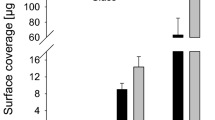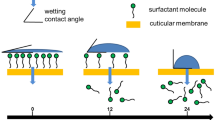Abstract
The effects of ethoxy (EO) chain length on surfactant-induced ethylene production for selected octylphenoxy (OP) and linear alcohol (LA) surfactants were established using primary leaves of cowpea (Vigna unguiculata (L.) Walp. subsp. unguiculata ‘Dixielee’) seedlings. OP surfactant-induced ethylene production was concentration dependent and decreased log linearly with increasing EO content. C12–15 LA-induced ethylene production decreased log linearly with increasing EO content at 0.1%; however, at 1.0% the relationship was curvilinear with maximum response at 7 EO. Relationships for the C9–11 and C9 LA series were nonlinear with greatest biological activity at intermediate (8–12) EO content. Short EO chain length OP surfactants were only slightly water soluble, and induced low levels of ethylene production and phytotoxicity. Addition of OP+1EO to a long chain, water soluble, non-ethylene inducing surfactant (OP+40EO) solution significantly increased ethylene production by OP+1EO in cowpea. A similar response was found for surfactant-induced phytotoxicity and EO chain length as between ethylene production and EO content. Similar EO chain length and ethylene production relationships were found for germinating mung bean (Vigna radiata (L.) R. Wilcz) seeds as for ethylene production and phytotoxicity in cowpea. Radicle growth was markedly inhibited by OP surfactants with an EO chain length of 10 or less and, in some cases, radicles were irreversibly damaged by ethylene inducing surfactants.
Similar content being viewed by others
References
Buchanan GA (1965) Patterns of surfactant toxicity to plant tissues. Ph.D. Diss., Iowa State Univ., Ames (Diss Abstr 65–7599)
Currier HB and Dybing CD (1959) Foliar penetration of herbicides — review and present status. Weeds 7: 195–213
Davis DG and Stolzenberg RL (1986) Effects of a homogeneous linear alcohol ethylene oxide surfactant on the ultra structure of soybean cell suspension cultures. Can J Bot 64: 618–625
Egan RW, Jones MA and Lehninger AL (1976) Hydrophile-liophile balance and critical micelle concentration as key factors influencing surfactant disruption of mitochondrial membranes. J Biol Chem 251: 4442–4447
Eisensmith SP (1987) PlotIT. Intractive Graphics and Statistics, Scientific Programming Enterprises: Haslett, MI
Furmidge GCL (1959) Physio-chemical studies on agricultural sprays: III. Variation of phytotoxicity with the chemical nature of surface-active agents. J Sci Food Agric 10: 419–425
Lownds NK and Bukovac MJ (1983) Surfactant enhanced penetration of growth regulators. Proc 10th Annu. Plant Growth Regulat Soc Amer p. 42
Lownds NK and Bukovac MJ (1988) Studies on octylphenoxy surfactants: V. Toxicity to cowpea leaves and effects of spray application parameters. J Amer Soc Hort Sci 113: 205–210
Lownds NK and Bukovac MJ (1989) Surfactant-induced ethylene production by leaf tissue. J Amer Soc Hort Sci 114: 449–454
McCoy RN and Bullock AB (1969) Determination of oxyethylene distribution in condensates of primary alcohols with ethylene oxide. J Amer Oil Chem Soc 46: 289–295
Noga GJ and Bukovac MJ (1986) Impact of surfactants on fruit quality of “Schattenmorelle” sour cherry and “Golden Delicious” apples. 5th Intl Symp on Growth Regulators in Fruit Prod Acta Hort 179: 771–778
Rohm and Haas Co. (1982) Triton Surface Active Agents. Nonionic alkylphenyl polyether alcohols. Bull. CS 40. Rohm and Hass Co., Philadelphia, PA
Seaman D (1982) Pesticide surfactant systems. A multiplicity of surfactant physical properties employed to improve the biological effects. pp. 1365–1380 In: Mittal KL and Fender EJ, eds. Solution Behavior of Surfactants: Theoretical and Applied Aspects. Plenum, New York
Shafer WE, Bukovac MJ and Fader RG (1989) Studies on octylphenoxy surfactants: Their sorption and effects on NAA partitioning into plant cuticles. In. Adjuvants and Agrochemicals, Vol. II: Recent Development, Application, and Bibliography of Agro-Adjuvants; pp. 39–49; Chow P, Grant C, Hinshalwood AM and Simundsson E, eds. CRC Press, Boca Raton, FL (1989)
Silcox D and Holloway PJ (1989) Foliar absorption of some nonionic surfactants from aqueous solutions in the absence and presence of pesticidal active ingredients. pp. 115–128. In. Adjuvants and Agrochemicals; Vol. I. Mode of Action and Physiological Activity; Chow P, Grant C, Hinshalwood AM and Simundsson E, eds. CRC Press, Boca Raton, FL
Stevens PJG and Bukovac MJ (1987) Studies on octylphenoxy surfactants: II. Effects on foliar uptake and translocation. Pestic Sci 20: 19–25
Stolzenberg GE, Olson PA, Zaylskie RG and Mansager ER (1982) Behavior and fate of ethoxylated alkylphenol nonionic surfactant in barley plants. J Agric Food Chem 30: 637–644
Author information
Authors and Affiliations
Rights and permissions
About this article
Cite this article
Lownds, N.K., Bukovac, M.J. Studies on octylphenoxy surfactants: X. Effect of oxyethylene chain length on ethylene production by cowpea and mung bean and comparison with linear alcohol hydrophobes. Plant Growth Regul 11, 139–145 (1992). https://doi.org/10.1007/BF00024067
Received:
Accepted:
Issue Date:
DOI: https://doi.org/10.1007/BF00024067




